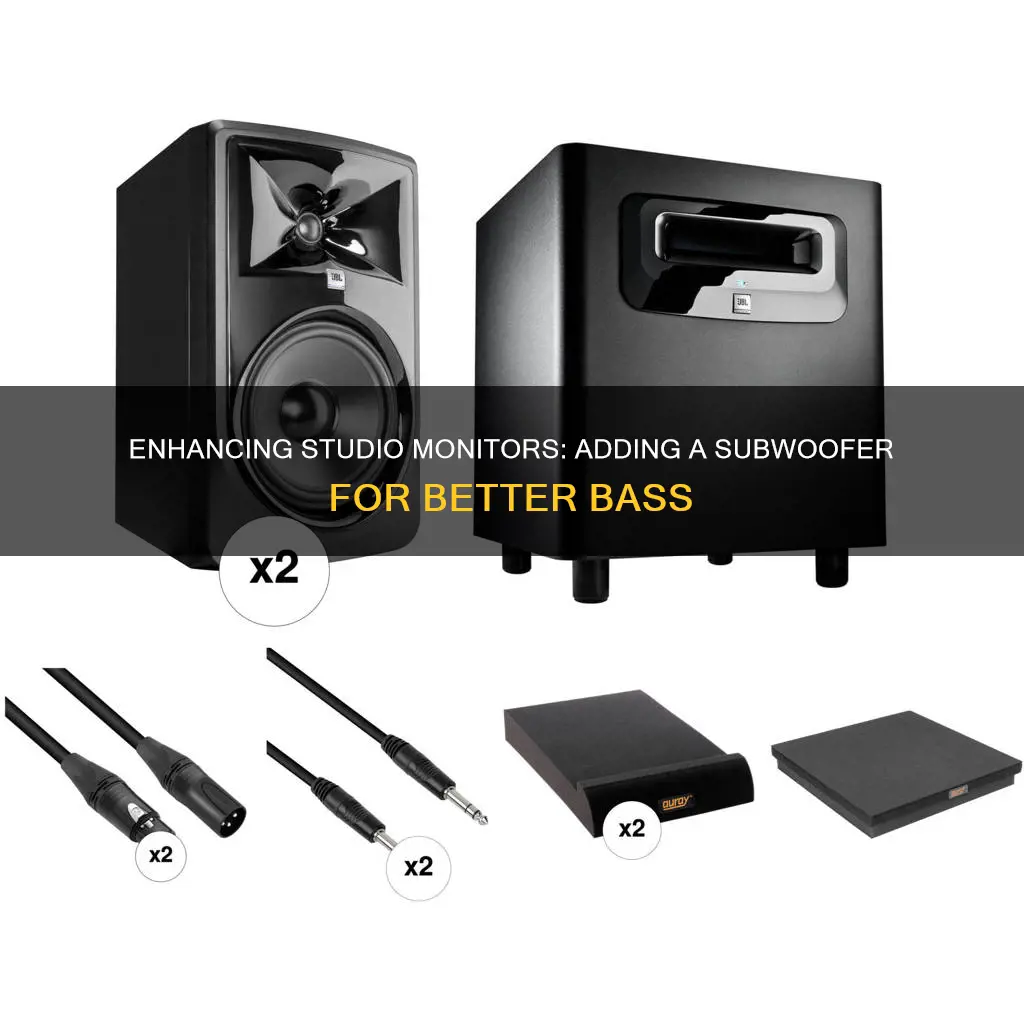
Adding a subwoofer to studio monitors can improve the bass frequencies that your speakers cannot output. This is especially useful when the bass needs to be perfect, punchy, and without distortion in big venues. It is important to calibrate the subwoofer to provide the right amount of bass to avoid throwing off the accuracy of your system with too much low-end. Before setting up a subwoofer, it is essential to consider whether your studio setup requires one. If you use small monitors, upgrading to larger speakers with larger woofers might be a better solution. When connecting a subwoofer, it is recommended to use high-quality shielded cables to avoid noise, interference, and signal degradation. The placement of the subwoofer is also crucial, as proximity to walls and corners can increase the volume and distort the frequency response.
What You'll Learn

Choosing the right subwoofer
Purpose of a Subwoofer
It's important to understand that the primary purpose of a subwoofer is to provide lower bass frequencies, not louder bass. Subwoofers reveal the lower spectrum of frequencies, allowing you to make informed mixing and EQ decisions. By pairing your monitors with a subwoofer, you can achieve a "2.1 system," extending the range and quality of your monitoring system.
Room Size and Acoustics
Consider the size of your studio and the acoustics of the space. If you have a smaller studio, a sealed subwoofer is often the optimal choice, provided it can deliver the required sound pressure levels (SPLs) and reach the desired low frequencies. In contrast, if your studio is large and sealed subs don't provide sufficient volume compared to your monitors, a ported subwoofer tuned low may be a better option.
Driver Size and Air Movement
Larger subwoofer drivers generally move more air than smaller ones, assuming they are moving the same amount. Look for high excursion drivers with thick rubber surrounds, as they indicate the ability to reach lower frequencies. A 12" driver is typically sufficient to hit the lower twenties in a sealed box.
Power and Amplification
Most subwoofers come equipped with class-D plate amplifiers, ranging from 100 watts up to several kilowatts. While more power is generally beneficial, especially for inefficient sealed subs, don't get too caught up in the numbers. Focus on finding a subwoofer that delivers the required SPLs for your space.
Active vs Passive Subwoofers
Active subwoofers are powered and contain an internal amplifier, while passive subwoofers are unpowered and require an external amplifier. Active subwoofers are more common in professional audio settings, while passive subwoofers are more commonly found in consumer hi-fi options.
Manufacturer Recommendations
If the manufacturer of your studio monitors offers a matching subwoofer, that is usually the best option. A dedicated subwoofer designed specifically for your monitors ensures that the system works harmoniously, with the subwoofer filling in the frequencies that your monitors are missing. If a dedicated subwoofer is not available, consider choosing a subwoofer from the same brand to ensure compatibility.
Variable High-Pass Filters
Look for subwoofers with built-in variable high-pass filters, also known as low-cut filters. These filters allow you to adjust which frequencies the subwoofer produces and which frequencies are passed on to the main speakers. This feature simplifies the integration process and ensures a smooth transition between the subwoofer and your monitors.
Crossover Frequency and Phase
The crossover frequency is crucial in ensuring a seamless transition between your subwoofer and monitors. Adjust the crossover frequency so that the subwoofer takes over just below the frequency range of your monitors. Properly setting the crossover frequency prevents overlap and creates a clear, cohesive sound. Additionally, ensure that your subwoofer and monitors are aligned vertically to avoid phase cancellation issues.
Removing Delta Monitor Shower Valve: A Step-by-Step Guide
You may want to see also

Connecting the subwoofer and studio monitors
If you are using an active subwoofer with stereo audio, do not connect it to a separate line output on your interface. Instead, connect the left and right outputs that you usually connect to your studio monitors, directly to the subwoofer's left and right inputs. Then, connect the left and right subwoofer outputs to your left and right monitor speakers. This allows the subwoofer's amplifier to receive the full frequency range audio from your interface.
If you are using a passive subwoofer, you will typically also need an amplifier or home receiver to power the speakers. In this case, the stereo line outputs would connect to the amplifier/receiver's left and right inputs, which would then act as the crossover/amplifier to split the audio signal and send it to the subwoofer and monitors.
Once the equipment is connected, you will need to set the crossover frequency to ensure the subwoofer and monitors do not overlap and create a muddy sound. Refer to the technical manual for your monitors and look for the frequency response graph, which shows the range of frequencies your speakers can effectively reproduce. Set the crossover frequency just before the response starts to drop off, which is typically between 20Hz and 100Hz.
After setting the crossover frequency, fine-tune the subwoofer's output level to achieve the desired amount of bass. This can be done by using acoustical measurement software or by listening to reference tracks and adjusting the subwoofer level until the bass sounds full yet realistic.
Lastly, consider the placement of your subwoofer in the room. Lower frequencies are less directional than high frequencies, so the exact location near your desk is not as critical. However, keep the subwoofer away from walls and corners as they can increase the sub's volume and distort its frequency response.
Water Usage Monitoring in California: How Does It Work?
You may want to see also

Setting the crossover frequency
To set the crossover frequency, first, refer to the technical manual for your studio monitors. Look for the frequency response graph, which shows the range of frequencies that your monitors can effectively reproduce. The response will typically drop off somewhere between 20Hz and 100Hz. This is the range within which you'll want to set the crossover. If there is a noticeable bump or dip in the response just before the drop-off, you may want to set the crossover frequency higher to avoid any unwanted peaks or dips in the bass response.
As a general rule, set the crossover point roughly 10Hz above the lowest frequency your speakers can handle cleanly. For example, if your speakers can handle frequencies down to 50Hz, set the crossover point at 60Hz. This ensures a smooth transition between your speakers and subwoofer, creating a seamless and cohesive sound.
It's worth noting that most modern AV receivers have an auto EQ program that will automatically set the proper crossover frequency based on your loudspeakers' capabilities. In most cases, it's best to leave these settings as they are. However, if you're using an AV processor, preamplifier, or a DSP subwoofer, you may need to adjust the crossover frequency manually to achieve the best performance.
When adjusting the crossover frequency, pay attention to the transition between the speakers and the subwoofer. Listen for any bass bumps at the crossover frequency and adjust the volume to match the output of your main speakers if needed. The goal is to achieve a flat frequency response and a natural, balanced sound.
Additionally, consider using a subwoofer matching tool or acoustical measurement software to fine-tune the crossover frequency and output level of your subwoofer. These tools can help you achieve a more precise and accurate setup, ensuring that your studio monitors and subwoofer work harmoniously together.
Ankle Monitors: Comfortable or a Constant Annoyance?
You may want to see also

Fine-tuning the subwoofer's output level
Initial Setup:
- Ensure your subwoofer is connected to your studio monitors and placed in an optimal position. A common recommendation is to place the subwoofer between your monitors to achieve an even bass distribution.
- Refer to the technical specifications of your studio monitors to identify their frequency response range. This information will guide you in setting the crossover frequency for your subwoofer.
- Set the crossover frequency of your subwoofer slightly higher than the upper limit of your monitors' frequency response range. For example, if your monitors' frequency response drops off at 50Hz, set the crossover frequency of the subwoofer to around 80Hz.
- Calibrate your monitors by playing pink noise and adjusting their input levels until they reach the desired volume, typically around 82-85 dB.
Fine-Tuning Process:
- Turn off your monitors and play full-bandwidth pink noise through your subwoofer.
- Adjust the subwoofer's input level until it reaches the desired volume, typically a few decibels lower than your monitors. For example, if your monitors are set to 85 dB, set the subwoofer to around 79 dB.
- Switch the polarity of your subwoofer and listen for the position with the loudest and smoothest bass response. This will ensure optimal coupling between the subwoofer and your monitors.
- Play music with plenty of bass and adjust the subwoofer's level until it blends seamlessly with your monitors. The bass should sound full yet realistic, without overwhelming the rest of the soundstage.
- Utilize acoustic measurement software, such as Room EQ Wizard or Sonarworks Reference, to fine-tune the frequency response of your listening position. These tools will help you identify any anomalies or room modes that affect the bass response.
- If you don't have access to acoustic measurement software, rely on your ears and reference tracks. Listen to a variety of music genres with strong bass elements and adjust the subwoofer's level until the bass sounds balanced and natural.
- Pay attention to the overall balance of your sound system. The subwoofer should enhance the low-end frequencies without drowning out the mids and highs.
- Consider using an SPL meter or a phone app like Decibel X Pro to measure the sound pressure levels in your room. This can help you objectively calibrate your subwoofer's output.
Troubleshooting:
- Be mindful of phase cancellation issues. If you notice a decrease in bass response or other anomalies, try inverting the phase of the subwoofer's signal or physically moving it to a different position in the room.
- If you experience a time delay between your monitors and subwoofer, ensure they are properly aligned by adjusting the time delay settings on your system. This will ensure that the sound from all sources reaches your listening position at the same time.
- If you have a subwoofer with a high crossover frequency, be cautious of its placement. Placing it in a corner might cause the mid-bass to also sound like it's coming from the corner, affecting the overall soundstage.
- If you have the option, consider using a subwoofer from the same manufacturer as your studio monitors. This ensures that they are designed to work together seamlessly and simplifies the process of setting the driver crossover frequency.
The Acer LCD V173 Monitor: Compact and Sleek Design
You may want to see also

Troubleshooting phase cancellation
Identify the Problem
Phase issues can manifest in various ways, and it is important to recognise them early in the recording or mixing process. One common sign of phase cancellation is a thin-sounding signal with a lack of bass. You may also notice that the kick drum or bass guitar seems to move around the mix instead of coming from a fixed spot. Additionally, sounds panned to the centre might disappear, while hard-panned sounds remain, which is a common technique used in karaoke systems to remove the lead vocal.
Check Your Speakers
One of the simplest solutions to troubleshooting phase cancellation is to check your speaker wiring. Ensure that your monitors are not wired out of phase, as this can inadvertently reverse the polarity of one channel. This issue is commonly referred to as "out-of-phase wiring" and can often be corrected by flipping the phase on the affected channel.
Adjust Microphone Placement
If you are experiencing phase issues during the recording process, try adjusting the placement of your microphones. Even moving them slightly, by a fraction of an inch, can make a significant difference in the sound. The 3:1 Rule of Mic Placement is a helpful technique: when using two microphones, place the second mic three times the distance from the first mic as the first mic is from the source. This simple rule can help minimise phase problems caused by time delays between the mics.
Use a Phase Alignment Plugin
There are phase alignment plugins available that can help resolve phase issues and serve as creative tools. For example, the UAD Little Labs IBP Phase Alignment Tool Plug-In can be used to adjust the phase and improve the sound.
Fine-Tune Your Subwoofer Placement
As low-frequency sound waves are less directional, you typically don't need to worry about the precise placement of your subwoofer. However, its proximity to walls and corners can affect its performance. Keep the subwoofer away from walls and corners to avoid increasing the volume and distorting the frequency response.
Check Your Mix in Mono
Phase issues often become apparent when you sum your mix to mono. Make it a habit to regularly check your mix in mono, especially during the early stages of the mixing process when the arrangement is less dense. This will help you identify phase problems sooner and make them easier to fix.
Use Acoustical Measurement Software
To fine-tune your subwoofer's output level and achieve a flat response, utilise acoustical measurement software such as Fuzzmeasure or RoomEQWizard. These tools can assist in finding the right amount of bass by allowing you to make adjustments and measure the results empirically.
Remember that phase issues are a common challenge in audio engineering, and troubleshooting them may require a combination of these techniques. Don't hesitate to experiment and make adjustments until you achieve the desired sound.
Asus Monitors: LED vs OLED Technology Explained
You may want to see also
Frequently asked questions
Adding a subwoofer to your monitoring setup expands the spectrum of frequencies you can accurately monitor. It's not about boosting the bass in your studio, it's about getting access to low bass frequencies that your setup can output.
First, you need to decide if you need one. If you use small monitors and still find yourself lacking in bass, simply upgrading to larger speakers could solve your problems without the complications of adding a subwoofer. If you do need a subwoofer, in most cases, if the manufacturer of your monitors sells a subwoofer for that particular line of speakers, that should be your first choice. With a matching subwoofer, you’ll know the entire system was designed to work together.
Once you have your subwoofer, you need to decide where to put it. Since lower frequencies are much less directional than high frequencies, you don’t have to worry about super-specific placement—anywhere on the floor near your desk should be fine. Keep it away from walls and corners as they will naturally increase the sub’s volume and distort its frequency response.
The proper way of connecting a subwoofer and studio monitors with an audio interface is to connect the output of the audio interface to the inputs of the subwoofer, and then connect the output of the subwoofer to the studio monitors. You will need a crossover: a circuit that splits the incoming audio signal into low- and high-frequency bands to be sent to the subwoofer and the monitors, respectively.







